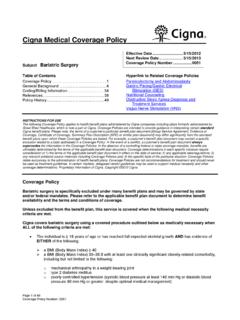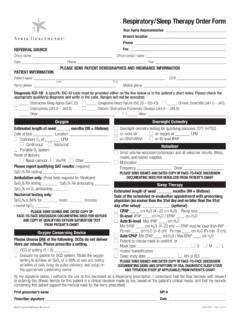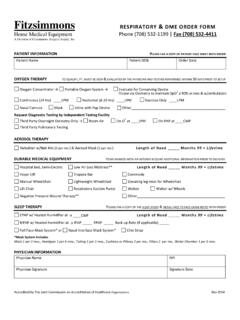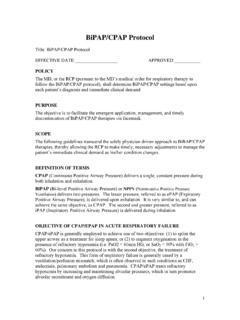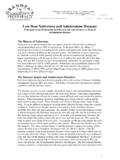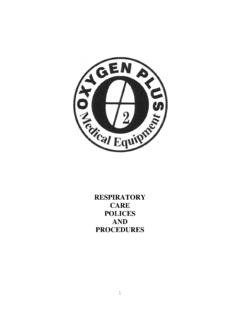Transcription of Sleep Studies, Adult
1 Sleep studies , Adult Medical Coverage Policy Effective Date: 10/24/2013 Revision Date: 10/24/2013 Review Date: 8/22/2013 Policy Number: CLPD-0381-014 Page: 1 of 23 Change Summary: Updated Coverage Limitations Humana's documents are updated regularly online. When printed, the version of this document becomes uncontrolled. Do not rely on printed copies for the most up-to-date version. Refer to to verify that this is the current version before utilizing. Disclaimer Description Coverage Determination Background Medical Alternatives Provider Claims Codes Medical Terms References Disclaimer State and federal law, as well as contract language, including definitions and specific inclusions/exclusions, take precedence over clinical policy and must be considered first in determining eligibility for coverage.
2 Coverage may also differ for our Medicare and/or Medicaid members based on any applicable Centers for Medicare & Medicaid Services (CMS) coverage statements including National Coverage Determinations (NCD), Local Medical Review Policies (LMRP) and/or Local Coverage Determinations. See the CMS website at The member's health plan benefits in effect on the date services are rendered must be used. Clinical policy is not intended to pre-empt the judgment of the reviewing medical director or dictate to health care providers how to practice medicine. Health care providers are expected to exercise their medical judgment in rendering appropriate care. Identification of selected brand names of devices, tests and procedures in a medical coverage policy is for reference only and is not an endorsement of any one device, test or procedure over another.
3 Clinical technology is constantly evolving, and we reserve the right to review and update this policy periodically. No part of this publication may be reproduced, stored in a retrieval system or transmitted, in any shape or form or by any means, electronic, mechanical, photocopying or otherwise, without permission from Humana. Description Note: This policy applies to Adult (18 years of age and older) patients only. For information regarding Sleep studies for children (less than 18 years of age), please refer to Sleep studies , Pediatric Medical Coverage Policy. A Sleep study is a test that may be used to assist in the diagnosis of Sleep disorders, such as Sleep apnea, narcolepsy and other night time behaviors. It can record a range of bodily functions during Sleep , such as: measurement of breathing, respiratory effort, oxygen saturation levels, heart monitoring, eye movement and heart, brain and muscle activity.
4 A Sleep study may be performed in a Sleep facility/laboratory or in the home. Polysomnogram (PSG) is a Sleep study that is performed in a facility/laboratory setting and requires an overnight stay. This test is designed to capture multiple sensory Sleep studies , Adult Effective Date: 10/24/2013 Revision Date: 10/24/2013 Review Date: 8/22/2013 Policy Number: CLPD-0381-014 Page: 2 of 23 Humana's documents are updated regularly online. When printed, the version of this document becomes uncontrolled. Do not rely on printed copies for the most up-to-date version. Refer to to verify that this is the current version before utilizing. channels including brain waves, heartbeat, blood pressure and breathing patterns as a patient sleeps. It can also record eye and leg movements, and muscle tension which can be useful in diagnosing parasomnias.
5 A PSG performed at a facility will record a minimum of twelve channels which is a minimum of 22 wire attachments to the patient. Sensors that send electrical signals to a computer are placed on the head, face, chest and legs. This test is attended by a technologist and the results are evaluated by a qualified physician. A PSG may be performed in conjunction with a positive airway pressure (PAP) machine to determine the titration of oxygen flow. Facility based positive airway pressure (PAP) titration study is used to set the right level of PAP which can be administered as continuous positive airway pressure (CPAP) or bilevel positive airway pressure (BPAP) once patient tolerance and optimal levels are determined by a Sleep technologist. Facility based titration is indicated for patients who are not candidates for auto titrating CPAP due to diminished ventilation from disorders such as chronic obstructive pulmonary disease (COPD), obesity hypoventilation syndrome (OHS) or heart failure.
6 Facility based PAP titration may be performed in conjunction with a PSG as part of a second or split night study if the diagnosis of moderate or severe OSA can be made within the first two hours of recorded Sleep , and at least three hours of PAP titration, including the ability of PAP to eliminate respiratory events during both rapid eye movement Sleep and non rapid eye movement Sleep , is demonstrated. Facility based, daytime, abbreviated, cardiorespiratory Sleep studies (PAP NAP testing) uses a therapeutic framework that includes mask and pressure desensitization, emotion focused therapy to overcome aversive emotional reactions, mental imagery to divert patient attention from mask or pressure sensations and physiological exposure to PAP therapy during a 100 minute nap period which is purported to enhance PAP therapy adherence.
7 (Refer to Coverage Limitations section) Multiple Sleep Latency Test (MSLT) is a facility based study that is used to measure levels of daytime sleepiness. During a routine MSLT, a patient is given five nap trials that are separated by two hour intervals: each trial consists of a twenty-minute session in which the patient attempts to fall asleep. Onset of Sleep and rapid eye movement, along with heartbeat and chin movements are recorded. The test is typically performed on the night following a PSG (where at least six hours of Sleep See the DISCLAIMER. All Humana member health plan contracts are NOT the same. All legislation/regulations on this subject may not be included. This document is for informational purposes only. Sleep studies , Adult Effective Date: 10/24/2013 Revision Date: 10/24/2013 Review Date: 8/22/2013 Policy Number: CLPD-0381-014 Page: 3 of 23 Humana's documents are updated regularly online.)
8 When printed, the version of this document becomes uncontrolled. Do not rely on printed copies for the most up-to-date version. Refer to to verify that this is the current version before utilizing. were achieved) in order to rule out other Sleep disorders as a cause of excessive daytime sleepiness. The results of the study are primarily used to confirm the suspected diagnosis of narcolepsy. Maintenance of Wakefulness Test (MWT) is a facility based study that is used to measure the ability to stay awake and alert. The procedure protocol is similar to that of the MSLT, with the exception that a patient is given four nap trials, each trial consisting of a forty minute session in which the patient attempts to fall asleep. The clinical setting should have a constant, low level of light that allows the patient to see and focus on objects in the room, but is not overly stimulating.
9 The test is routinely performed the day after a nocturnal PSG and evaluates the ability to stay awake for a defined period of time. Results may be used to determine the efficacy of therapy for Sleep disturbance disorders (such as narcolepsy) or to determine if the inability to stay awake is a public or personal safety concern. Home/Portable Monitor Sleep Testing is a Sleep study performed in the home that utilizes portable monitoring (PM) devices that are designed to be used by a patient without supervision of a Sleep technologist. The system usually consists of a recording device and related accessories. PM devices measure fewer parameters than a laboratory based Sleep study. The American Academy of Sleep Medicine (AASM) has recently suggested categorizing home Sleep testing devices based on measurements of Sleep , Cardiovascular, Oximetry, Position, Effort, and Respiratory (SCOPER) parameters.
10 However, the currently used Type I-IV classification system is described below. NOTE: Only those monitors that record airflow, respiratory effort, and blood oxygenation (at a minimum) are considered effective for the evaluation of Sleep apnea. Type I monitoring devices are used for in laboratory, technologist attended, overnight PSG. They measure a minimum of seven parameters including electroencephalogram (EEG), electrocardiogram (ECG), electrooculogram, chin electromyogram, airflow, respiratory effort and oxygen saturation. Type II monitoring devices record a minimum of seven monitoring channels, the same as Type I devices; however, Type II monitoring devices are portable, used outside the Sleep lab and are unattended by a Sleep technologist. See the DISCLAIMER. All Humana member health plan contracts are NOT the same.

